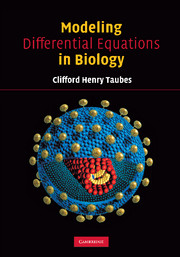Book contents
- Frontmatter
- Contents
- Preface
- Chapter 1 Introduction
- Chapter 2 Exponential Growth
- Chapter 3 Introduction to Differential Equations
- Chapter 4 Stability in a One-Component System
- Chapter 5 Systems of First-Order Differential Equations
- Chapter 6 Phase Plane Analysis
- Chapter 7 Introduction to Vectors
- Chapter 8 Equilibrium in Two-Component, Linear Systems
- Chapter 9 Stability in Nonlinear Systems
- Chapter 10 Nonlinear Stability Revisited
- Chapter 11 Matrix Notation
- Chapter 12 Remarks About Australian Predators
- Chapter 13 Introduction to Advection
- Chapter 14 Diffusion Equations
- Chapter 15 Two Key Properties of the Advection and Diffusion Equations
- Chapter 16 The No-Trawling Zone
- Chapter 17 Separation of Variables
- Chapter 18 The Diffusion Equation and Pattern Formation
- Chapter 19 Stability Criterion
- Chapter 20 Summary of Advection/Diffusion
- Chapter 21 Traveling Waves
- Chapter 22 Traveling Wave Velocities
- Chapter 23 Periodic Solutions
- Chapter 24 Fast and Slow
- Chapter 25 Estimating Elapsed Time
- Chapter 26 Switches
- Chapter 27 Testing for Periodicity
- Chapter 28 Causes of Chaos
- Extra Exercises and Solutions
- Index
Chapter 26 - Switches
Published online by Cambridge University Press: 05 June 2012
- Frontmatter
- Contents
- Preface
- Chapter 1 Introduction
- Chapter 2 Exponential Growth
- Chapter 3 Introduction to Differential Equations
- Chapter 4 Stability in a One-Component System
- Chapter 5 Systems of First-Order Differential Equations
- Chapter 6 Phase Plane Analysis
- Chapter 7 Introduction to Vectors
- Chapter 8 Equilibrium in Two-Component, Linear Systems
- Chapter 9 Stability in Nonlinear Systems
- Chapter 10 Nonlinear Stability Revisited
- Chapter 11 Matrix Notation
- Chapter 12 Remarks About Australian Predators
- Chapter 13 Introduction to Advection
- Chapter 14 Diffusion Equations
- Chapter 15 Two Key Properties of the Advection and Diffusion Equations
- Chapter 16 The No-Trawling Zone
- Chapter 17 Separation of Variables
- Chapter 18 The Diffusion Equation and Pattern Formation
- Chapter 19 Stability Criterion
- Chapter 20 Summary of Advection/Diffusion
- Chapter 21 Traveling Waves
- Chapter 22 Traveling Wave Velocities
- Chapter 23 Periodic Solutions
- Chapter 24 Fast and Slow
- Chapter 25 Estimating Elapsed Time
- Chapter 26 Switches
- Chapter 27 Testing for Periodicity
- Chapter 28 Causes of Chaos
- Extra Exercises and Solutions
- Index
Summary
The fast and slow analysis of the heart model from Chapter 24 can be applied in a more general context. In particular, the fast-slow analysis applies when two systems (or populations) interact and where the reaction time of one is much faster than that of the other.
To illustrate how this works, consider first an example that is suggested by the article from Reading 24.1: The example considers the coevolution of pocket gophers and their mite parasites. The mites can be considered to be the fast system and the gophers the slow system, inasmuch as the generation time for mites can be as short as a few days or weeks, while gophers typically have one or at most two litters per year. The point is that the fast generation time of the mite allows the latter to adapt quickly (relatively speaking) to environmental changes, while the adaptation time of gophers is much slower. To be slightly more specific, take g(t) to denote some property of gophers under consideration at time t, and take m(t) to denote some property of mites. [For example, g(t) might represent the fraction of gophers with some particular blood type, and m(t) might denote the fraction of mites that preferentially feed on that blood type.]
Information
- Type
- Chapter
- Information
- Modeling Differential Equations in Biology , pp. 416 - 429Publisher: Cambridge University PressPrint publication year: 2008
